If you’re looking to add a touch of luxury to your cooking, look no further than cognac. This rich and complex spirit has been a staple in high-end cuisine for centuries, and for good reason.
Cognac’s bold flavor and aroma make it an ideal ingredient for a variety of dishes, from savory sauces to sweet desserts. In this article, we’ll explore the world of cognac food recipes, from the history of cognac in cuisine to essential recipes and cooking techniques.
The History of Cognac in Cuisine Cognac has been a fixture in French cuisine since the 18th century, when it was first distilled in the Charente region of southwestern France. Originally used as a medicinal tonic, cognac quickly became popular as a drink among the French aristocracy.
It wasn’t long before chefs began experimenting with cognac in their cooking, using it as a flavor enhancer and a way to add depth and complexity to their dishes. Today, cognac remains a beloved ingredient in French cuisine, and its popularity has spread to kitchens around the world.
Key Takeaways
- Cognac has been a staple in high-end cuisine for centuries, adding a touch of luxury to dishes.
- Cognac’s bold flavor and aroma make it an ideal ingredient for a variety of dishes, from savory sauces to sweet desserts.
- Cognac has a rich history in French cuisine and remains a beloved ingredient in kitchens around the world.
The History of Cognac in Cuisine
Cognac, a type of brandy produced in the Cognac region of France, has been used in cuisine for centuries. Its unique flavor profile and high alcohol content make it a versatile ingredient in both sweet and savory dishes.
In the 19th century, cognac was commonly used in French cuisine to add depth of flavor to sauces and marinades. It was also used in desserts, such as the classic French dessert, “Poires Belle Hélène,” which features poached pears served with vanilla ice cream and a warm cognac chocolate sauce.
Today, cognac is still used in French cuisine, but its use has spread to other countries and cultures as well. In the United States, cognac is often used in barbecue sauces, marinades, and glazes for meats. It is also a popular ingredient in cocktails, such as the classic Sidecar.

When cooking with cognac, it is important to choose a high-quality brand that will impart the desired flavor and aroma. It is also important to use cognac sparingly, as its high alcohol content can easily overpower other flavors in a dish.
Overall, cognac adds a unique and sophisticated touch to any dish, and its use in cuisine is a testament to its versatility and enduring popularity.
Selecting the Right Cognac for Cooking
When it comes to cooking with cognac, selecting the right type of cognac can make all the difference in the final outcome of your dish. Here are some things to consider when choosing a cognac for cooking.
Understanding Cognac Grades
Cognac is classified into different grades based on the age of the cognac. The grades are VS (Very Special), VSOP (Very Superior Old Pale), and XO (Extra Old). The age of the cognac is determined by the youngest eau-de-vie (a clear, colorless fruit brandy) used in the blend.

For cooking purposes, VS cognac is usually the best choice as it is the youngest and has a more pronounced alcohol flavor. VSOP and XO cognacs have a smoother and more complex flavor profile, which can get lost in cooking.
Flavor Profiles of Different Cognacs
Different cognacs have different flavor profiles, which can affect the taste of your dish. Here are some general flavor profiles of different cognacs:
- VS cognacs have a fruity and floral flavor with a hint of vanilla.
- VSOP cognacs have a more mature flavor with notes of oak, dried fruit, and spices.
- XO cognacs have a complex and sophisticated flavor with notes of leather, tobacco, and dark chocolate.
When selecting a cognac for cooking, consider the flavor profile of the cognac and how it will complement the other ingredients in your dish. For example, a VS cognac may be a good choice for a fruit-based dessert, while a VSOP cognac may work well in a savory dish with rich flavors.
In conclusion, selecting the right cognac for cooking can elevate the flavor of your dish. When choosing a cognac, consider the age and flavor profile of the cognac and how it will complement the other ingredients in your dish.
Essential Cognac Food Recipes
Cognac is not just a drink to be enjoyed on its own, it can also be used as a key ingredient in cooking. Adding a splash of cognac to your favorite recipe can elevate the flavors to a whole new level. Here are some essential cognac food recipes that you need to try:
Cognac-Infused Main Courses
Cognac can be used in a variety of main courses, from chicken to beef to seafood. One popular cognac-infused recipe is Beef Bourguignon.
This classic French dish is made with beef, bacon, onions, and mushrooms, all cooked in a rich sauce made with red wine and cognac. The cognac adds a depth of flavor that takes this dish to the next level.
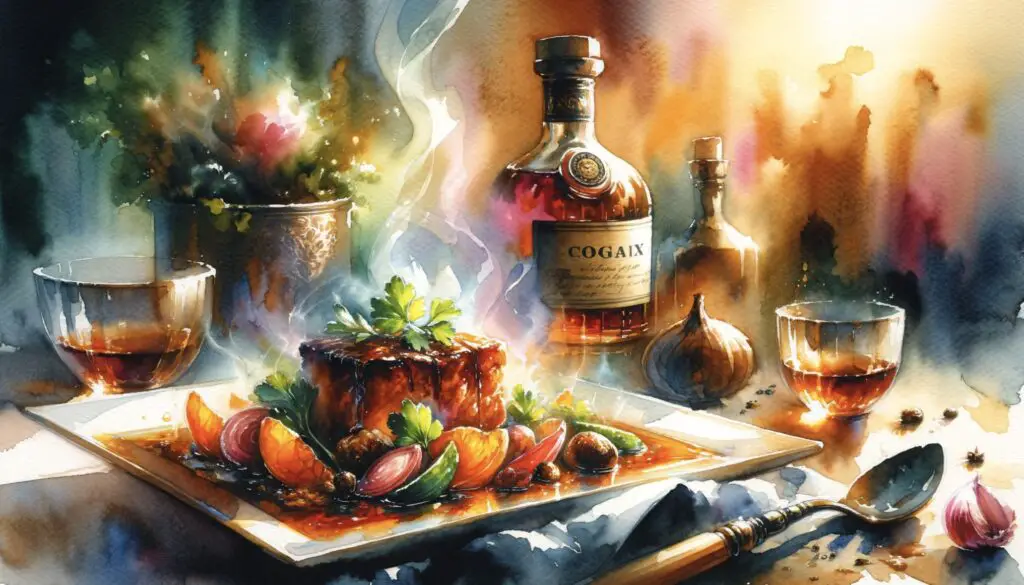
Another great cognac-infused main course is Chicken with Cognac and Cream. This dish is made with chicken breasts, mushrooms, shallots, and garlic, all cooked in a creamy sauce made with cognac. The cognac adds a subtle sweetness to the dish that balances out the creaminess perfectly.
Cognac Desserts
Cognac can also be used in desserts, adding a rich and complex flavor to sweet treats. One classic cognac dessert is Crêpes Suzette. This French dessert is made with thin pancakes filled with a buttery orange sauce made with cognac. The cognac adds a subtle warmth to the dish that complements the citrus perfectly.
Another delicious cognac dessert is Chocolate Truffles with Cognac. These rich and decadent truffles are made with dark chocolate, heavy cream, and cognac. The cognac adds a subtle boozy flavor to the truffles that makes them perfect for special occasions.
In conclusion, cognac is a versatile ingredient that can be used in a variety of recipes, from main courses to desserts. Adding a splash of cognac to your favorite recipe can take it to the next level and impress your dinner guests. Try these essential cognac food recipes and discover the amazing flavors that cognac can bring to your cooking.
Cooking Techniques with Cognac
Cognac is a versatile ingredient that can add depth and complexity to a variety of dishes. Here are two cooking techniques that use cognac to elevate your meals:
Flambéing with Cognac
Flambéing is a cooking technique that involves igniting alcohol to create a burst of flame. Cognac is a popular choice for flambéing because it has a high alcohol content and a distinctive flavor profile.
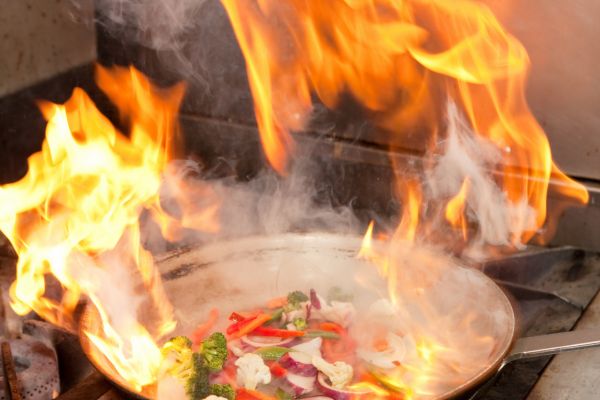
To flambé with cognac, heat a small amount of cognac in a pan until it is warm. Remove the pan from the heat and carefully ignite the cognac with a long match or lighter. Once the flame has died down, add your ingredients to the pan and continue cooking as usual.
Flambéing with cognac is a great way to add a rich, smoky flavor to dishes like steak, chicken, and seafood. Just be sure to use caution when igniting the cognac, and keep a lid nearby in case the flame gets out of control.
Marinating with Cognac
Marinating is a technique that involves soaking meat or vegetables in a flavorful liquid to infuse them with flavor and tenderize them. Cognac can be a great addition to marinades because it adds a subtle sweetness and a hint of oakiness.
To make a cognac marinade, combine cognac with other ingredients like olive oil, garlic, herbs, and spices. Place your meat or vegetables in the marinade and refrigerate for several hours or overnight.
When you’re ready to cook, remove the meat or vegetables from the marinade and discard the excess liquid. The cognac will have tenderized the meat and added a delicious depth of flavor.
Cognac marinades work well with a variety of meats, including beef, pork, and chicken. They can also be used to add flavor to vegetables like mushrooms and eggplant.
Incorporating cognac into your cooking can take your dishes to the next level. Whether you’re flambéing or marinating, experiment with different techniques and ingredients to find the perfect cognac recipe for you.
Cognac-Based Sauces and Condiments
If you’re looking to add a touch of sophistication to your meal, cognac-based sauces and condiments are an excellent choice. The rich, complex flavors of cognac can add depth and complexity to your dishes, whether you’re cooking with meat, seafood, or vegetables.
Cognac Mustard Sauce
Cognac mustard sauce is a classic condiment that pairs well with beef, pork, and chicken. To make this sauce, you’ll need Dijon mustard, cognac, butter, sugar, and a few other ingredients. Start by melting the butter in a saucepan over medium heat. Add the shallots and cook until they’re soft and translucent. Next, add the cognac and let it simmer for a minute or two. Then, add the Dijon mustard, sugar, and a pinch of salt. Stir the sauce until it’s smooth and creamy. This sauce is excellent for dipping or drizzling over your favorite dishes.
Sweet Cognac Reduction
If you’re looking for a sweet and savory sauce that’s perfect for drizzling over desserts or fruit, a sweet cognac reduction is an excellent choice. To make this sauce, you’ll need cognac, sugar, and a few other ingredients. Start by heating the cognac in a saucepan over medium heat. Add the sugar and stir until it’s dissolved. Let the mixture simmer until it’s reduced by about half. The sauce should be thick and syrupy. This sauce is perfect for drizzling over ice cream, fruit, or even pancakes.
Overall, cognac-based sauces and condiments are an excellent way to add flavor and sophistication to your meals. Whether you’re cooking with meat, seafood, or vegetables, cognac can add depth and complexity to your dishes. So why not give it a try and see how it can elevate your cooking?
Tips for Cooking with Cognac
If you’re new to cooking with cognac, here are some tips to help you get started:
1. Choose the Right Cognac
When cooking with cognac, it’s important to choose the right one for the job. Generally, you’ll want to use a VS or VSOP cognac for cooking, as they are less expensive and have a milder flavor than XO cognacs. However, if you’re making a dish that calls for a more intense cognac flavor, you may want to opt for an XO or even an Hors d’Age cognac.
2. Use Cognac in Small Amounts
Cognac is a potent spirit, so it’s important to use it in small amounts when cooking. A little bit of cognac can go a long way, and adding too much can overpower the other flavors in your dish. As a general rule, you’ll want to use no more than 1-2 tablespoons of cognac per recipe.
3. Add Cognac at the Right Time
When cooking with cognac, it’s important to add it at the right time to ensure the best flavor. In general, you’ll want to add cognac towards the end of the cooking process, after you’ve sautéed your aromatics and before you add your liquid ingredients. This will give the cognac time to cook off some of its alcohol and meld with the other flavors in your dish.
4. Don’t Overcook the Cognac
Cognac is a delicate spirit, and overcooking it can result in a harsh, bitter flavor. To avoid this, be sure to only cook your cognac for a minute or two, until it has had a chance to meld with the other flavors in your dish. If you’re making a sauce or gravy with cognac, you may want to remove it from the heat entirely before adding the cognac to ensure that it doesn’t overcook.
5. Experiment with Different Recipes
Finally, don’t be afraid to experiment with different recipes when cooking with cognac. Cognac can add a unique flavor to a wide range of dishes, from savory sauces and gravies to sweet desserts and cocktails. So, be creative and have fun with it!
Cognac Pairings and Accompaniments
When it comes to pairing cognac with food, there are a few things to keep in mind. First, cognac is a complex and nuanced spirit that can complement a wide variety of flavors. Second, you want to choose foods that will enhance the flavors of the cognac without overwhelming them. Here are a few suggestions for cheese and chocolate pairings that will help you get the most out of your cognac.
Cheese and Cognac
Cheese is a natural pairing for cognac, as the rich, creamy flavors of cheese can complement the complex flavors of cognac. Here are a few suggestions for cheeses to pair with cognac:
- Brie: This soft, creamy cheese has a mild flavor that pairs well with the smooth, mellow flavors of cognac.
- Roquefort: This tangy, salty blue cheese has a bold flavor that can stand up to the intensity of cognac.
- Gouda: This semi-hard cheese has a nutty, caramel-like flavor that pairs well with the sweet, woody flavors of cognac.
When pairing cheese with cognac, it’s important to choose a cognac that is similar in flavor intensity to the cheese. For example, a mellow brie would pair well with a VS or VSOP cognac, while a bold roquefort would pair well with an XO cognac.
Chocolate and Cognac
Chocolate and cognac are a match made in heaven, as the rich, decadent flavors of chocolate can complement the smooth, velvety flavors of cognac. Here are a few suggestions for chocolates to pair with cognac:
- Dark chocolate: This rich, intense chocolate pairs well with the deep, complex flavors of cognac.
- Milk chocolate: This creamy, sweet chocolate can balance out the intensity of cognac and bring out its sweeter notes.
- White chocolate: This delicate, buttery chocolate can complement the floral, fruity flavors of cognac.
When pairing chocolate with cognac, it’s important to choose a chocolate that is similar in sweetness to the cognac. For example, a sweet milk chocolate would pair well with a VS or VSOP cognac, while a rich, intense dark chocolate would pair well with an XO cognac.
Overall, cognac can be paired with a wide variety of foods, but cheese and chocolate are two of the best options. By choosing the right cheeses and chocolates to pair with your cognac, you can create a truly unforgettable culinary experience.
Cognac in Cocktails
Cognac is a versatile spirit that can be used in a variety of cocktails, both classic and modern. Its smooth and rich flavor profile makes it an excellent base for cocktails that require a strong and complex spirit. Here are a few classic and modern cognac cocktails that you can try at home.
Classic Cognac Cocktails
Sidecar
The Sidecar is a classic cocktail that has been around since the early 20th century. It is made with cognac, Cointreau, and lemon juice. The drink is typically served in a sugar-rimmed glass and garnished with a lemon twist. The Sidecar is a perfect example of how cognac can be used to create a balanced and flavorful cocktail.
French 75
The French 75 is another classic cocktail that is made with cognac, lemon juice, simple syrup, and champagne. The drink is typically served in a champagne flute and garnished with a lemon twist. The French 75 is a refreshing and elegant cocktail that is perfect for any occasion.

Modern Cognac Mixology
The Sazerac
The Sazerac is a modern twist on a classic cocktail that is made with cognac, absinthe, Peychaud’s bitters, and sugar. The drink is typically served in an Old Fashioned glass and garnished with a lemon or lime twist. The Sazerac is a bold and complex cocktail that is perfect for those who enjoy a strong and flavorful drink.
The Vieux Carré
The Vieux Carré is another modern cognac cocktail that is made with cognac, rye whiskey, sweet vermouth, Benedictine, and Peychaud’s bitters. The drink is typically served in a rocks glass and garnished with a lemon twist. The Vieux Carré is a complex and flavorful cocktail that is perfect for those who enjoy a strong and sophisticated drink.
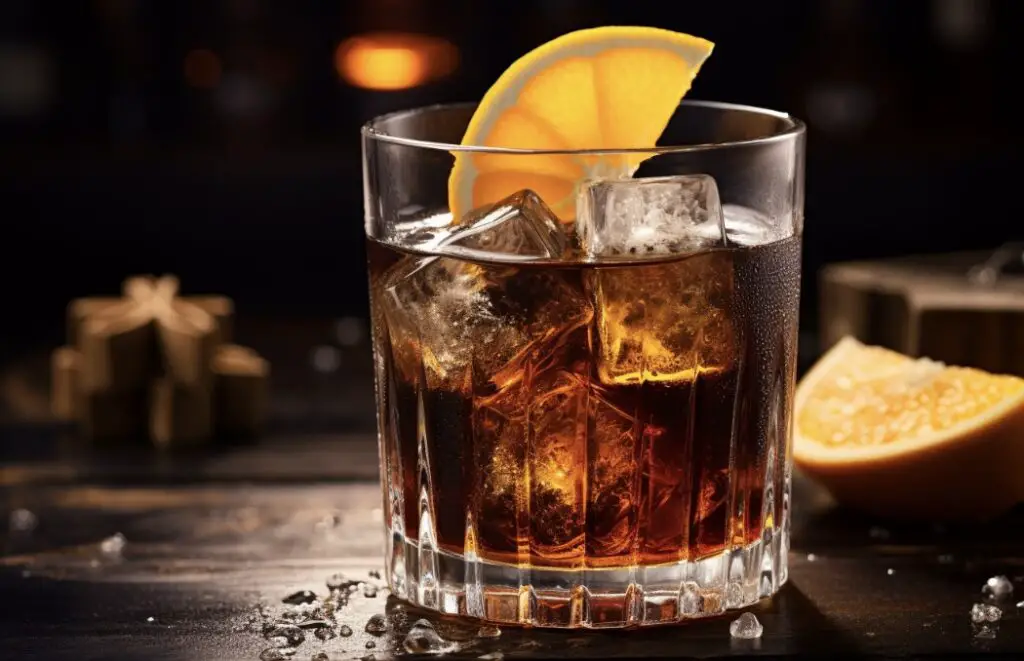
In conclusion, cognac is a versatile spirit that can be used in a variety of classic and modern cocktails. Whether you prefer a refreshing and elegant drink or a bold and complex cocktail, cognac is the perfect base for your next cocktail creation.
Healthy Cognac-Infused Dishes

Looking to add a touch of sophistication to your healthy meals? Look no further than cognac-infused dishes! Cognac is a type of brandy that can add depth and complexity to a variety of dishes. Plus, it’s a great way to add a touch of elegance to your meal without adding a ton of extra calories.
Here are a few healthy cognac-infused dishes to try:
1. Cognac-Glazed Salmon
Salmon is already a healthy choice, but add a cognac glaze and you’ve got a dish that’s both healthy and flavorful. To make the glaze, simply mix together cognac, honey, soy sauce, and garlic. Brush the glaze over the salmon fillets and bake in the oven for a delicious and healthy meal.
2. Cognac-Infused Quinoa Salad
Quinoa is a superfood that’s packed with protein and fiber, and it pairs perfectly with cognac in this tasty salad. Cook the quinoa according to package instructions, then mix in chopped vegetables, dried cranberries, and a dressing made with cognac, olive oil, and lemon juice.
3. Cognac-Marinated Chicken
Marinating chicken in cognac adds a depth of flavor that’s hard to beat. Simply mix together cognac, olive oil, garlic, and herbs, then marinate the chicken for a few hours before grilling or baking. Serve with a side of roasted vegetables for a healthy and delicious meal.
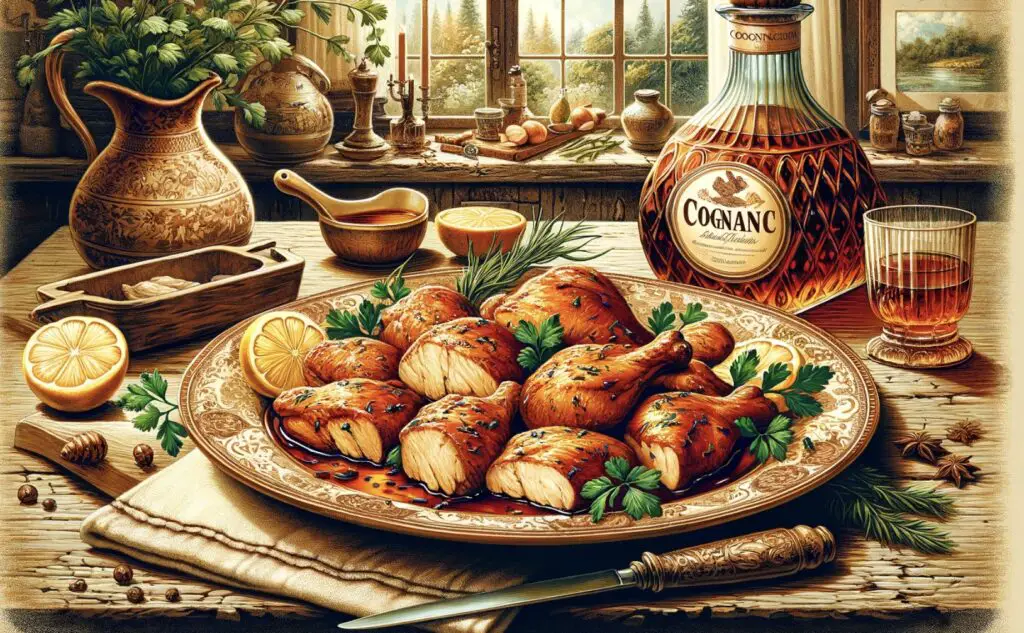
Adding cognac to your healthy meals is a great way to elevate your cooking game. Give these cognac-infused dishes a try and impress your taste buds!
Cognac Substitutes in Recipes
When it comes to cooking with cognac, sometimes you may find yourself without a bottle on hand. Fear not, for there are a few alternatives that can be used in place of cognac in your recipes.
Using Bourbon as an Alternative
Bourbon is a great substitute for cognac in recipes that call for a rich, sweet flavor. It is made from corn and aged in charred oak barrels, which gives it a distinct flavor profile. When using bourbon in place of cognac, keep in mind that it has a higher alcohol content, so you may want to use less than the recipe calls for.
Rye Whiskey in Place of Cognac
Rye whiskey is another option for those looking to substitute cognac in their recipes. It has a spicy, bold flavor that can add depth to dishes like stews and sauces. When using rye whiskey in place of cognac, be sure to choose a high-quality brand that has been aged for at least a few years.

Overall, while cognac is a unique and flavorful ingredient, there are alternatives that can be used in its place. Bourbon and rye whiskey are both great options that can add depth and complexity to your dishes. Just be sure to use them in moderation and choose high-quality brands for the best results.
Storing and Preserving Cognac for Culinary Use

When it comes to cooking with cognac, it’s important to know how to properly store and preserve it. Here are some tips to help you keep your cognac fresh and flavorful for culinary use:
- Store cognac in a cool, dark place: Cognac should be stored in a cool, dark place, away from direct sunlight and heat. This will help preserve its flavor and prevent it from spoiling.
- Use a sealed container: Once you’ve opened a bottle of cognac, it’s important to transfer it to a sealed container to prevent oxidation. Oxygen can cause the cognac to lose its flavor and aroma, so it’s important to keep it sealed.
- Keep it upright: When storing cognac, it’s best to keep the bottle upright. This will help prevent the cork from drying out and potentially contaminating the cognac.
- Avoid temperature fluctuations: Cognac should be stored at a consistent temperature, ideally between 60-65°F. Fluctuations in temperature can cause the cognac to expand and contract, which can affect its flavor and aroma.
- Use it within a reasonable time frame: Cognac can last for a long time if stored properly, but it’s best to use it within a reasonable time frame. Once opened, cognac should be used within 6 months to ensure optimal flavor and quality.
By following these tips, you can ensure that your cognac stays fresh and flavorful for use in your favorite culinary recipes.

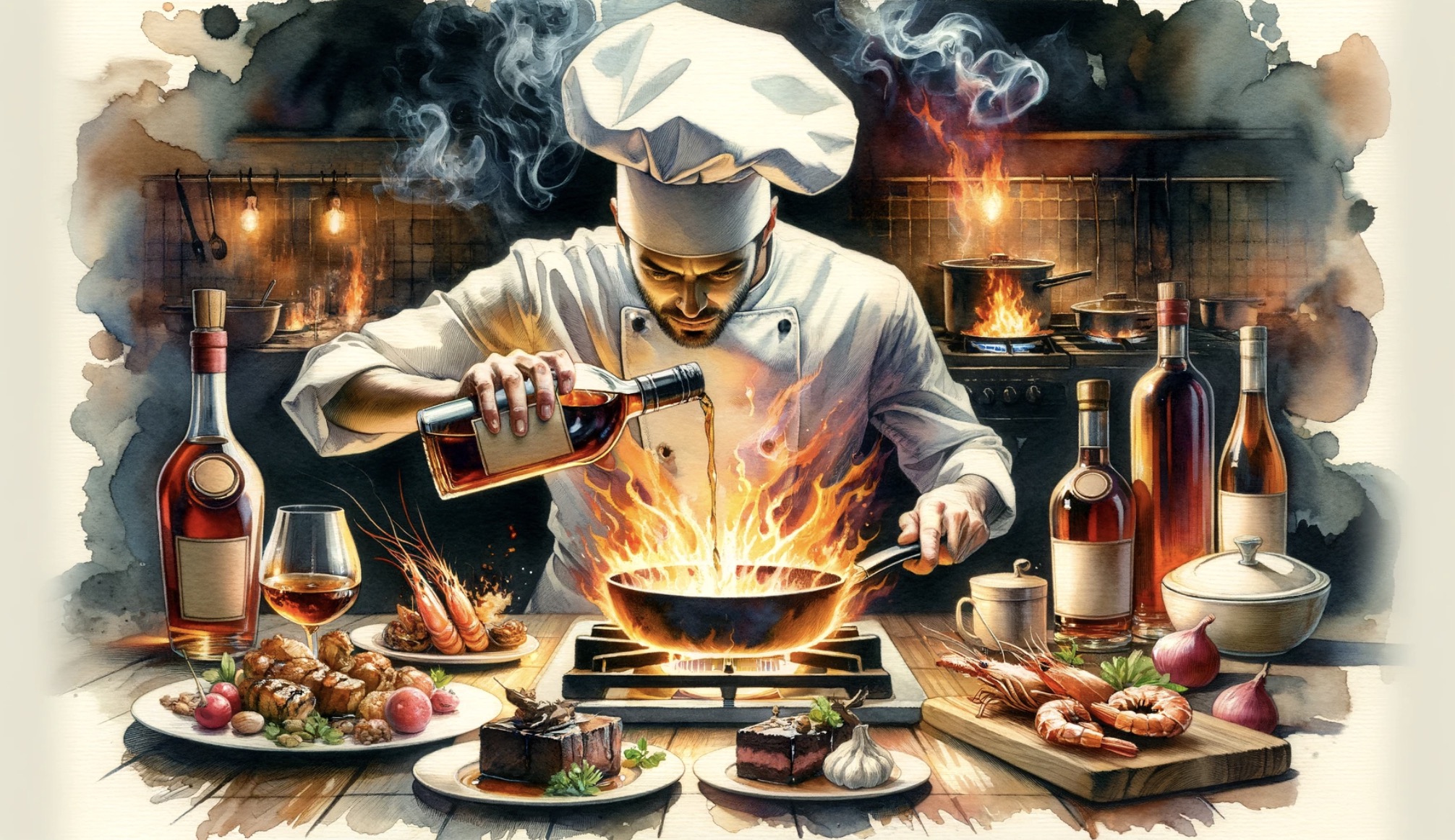



Leave a Reply
You must be logged in to post a comment.